How to Avoid a Scam
With so many convincing cons in play online and over the phone, it’s easy to feel like we’re all just one wrong move away from losing our life savings.
Nearly 2.2 million people reported losing a total of more than $3 billion to scams in 2020 alone, and a whopping 1.4 million reported identity theft — that's twice as many victims as in 2019.
How to spot a phone call or email scam
-
The caller’s phone number looks similar to yours. Fraudsters use software that mimics, or “spoofs,” local numbers to make incoming calls look as if they’re coming from your community so you’re more likely to answer.
-
The email address has a typo or seems "off." Always check the email header carefully; sometimes scammers will change just one or two letters in an email address. Hover over hyperlinks to view the web address they’ll direct you to; if they seem vague or inauthentic, don't click them.
- You’re pressured to act fast. Cons often create a sense of urgency. For example, it might be "This is the Social Security Administration, and your number has been suspended because of criminal activity." It could also be "This is Publishers Clearing House. You’ve won a million dollars!" Be aware that government agencies like the IRS will not call you out of the blue and demand payment.
- They request payment in gift cards. Any time somebody asks you to pay for some obligation by purchasing a gift card and sharing the numbers from the back, it is a scam — 100% of the time. It is not a legitimate form of payment.
Top tips to avoid a phone scam
-
Turn on call blockers. Register for the FTC Do Not Call Registry, and use the tools built into your phone and provided by your mobile carrier (e.g., AT&T Call Protect, Verizon Call Filter, T-Mobile Scam Shield). Check your smartphone’s settings to modify privacy options or enable call-blocking features.
-
Verify the phone number. If you suspect that a call you’ve answered from a business is a scam, hang up and find a valid phone number to call to confirm that the company reached out. The same goes for emails and texts: Don’t click provided links or open attachments.
- Create a refusal script, which provides language you can lean on when you needs to end a call. Keep the script next to your phone — or by your door, for unwanted or fishy solicitors — as reinforcement.
How to avoid getting scammed online
-
“Salt” your security questions. You might feel safer when websites require answers to security questions like ‘Name your high school mascot.’ But thanks to social media, a lot of personal info is available online. One strategy for staying safe is “salting” — sprinkling a little extra info into your answers to make them harder to hack. If, say, your high school mascot was a cougar, you can add a memorable word or number to your correct answer — e.g., Cougar719 or CougarDoritos (even better: CoUgarDor!t0s) — that others won’t know.
- Turn on multi-factor identification. Yes, it slows things down to have to enter a second code when accessing private data, but a minor inconvenience to you is a big inconvenience to scammers.
- Check your email settings. Mark unwanted emails as spam, strengthen your privacy options in your email security settings and have a secondary email account to use when you need to provide an email address for transactions.
- Always verify contact information independently. Do not call numbers provided in an email, text or letter; look up the business’s number before dialing.
Remember: MIT Federal Credit Union will never text, email or call you asking for personal or account information. Never click a link or download an attachment from someone you don't know. Fraud is on the rise; learn how to protect yourself.
« Return to "Blog"
Tags

What You Need to Know About Robocall Scams
Don’t get caught! Here’s what you need to know about robocall scams and how to avoid falling victim.

Ways to Spot a Loan Scam
Arm yourself with knowledge and awareness. Here’s how to spot a loan scam.

Beware Of Phishing Scams!
Unfortunately, hundreds of people are falling prey to phishing scams. Don’t be the next victim!





